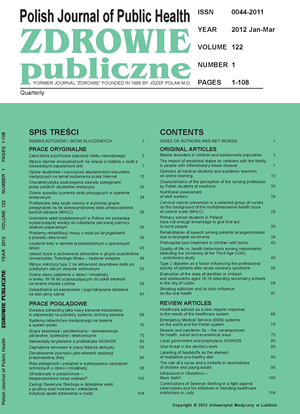Season and pandemic flu – the consequences for health, social and economical issue
Keywords:
influenza, complications, consequencesAbstract
Flu (influenza) is an acute infectious disease caused by the influenza virus type A, B or C of the family Orthomyxoviridae, which spreads mainly by droplet route and infected man is the source of disease. Every year 5-15% of the world population of suffer influenza, out of which in 3-5 million people with a grave course. Influenza lasts on average from a few to several days. Its episode gives immunity for the particular subtype of the virus, but the large antigenic variability of influenza viruses types A and B carries the threat of breaking that barrier and frequent infections. Most serious consequences of seasonal influenza and especially of pandemic influenza are complications within the upper and lower respiratory tract, cardiovascular system, central nervous system and kidneys. Being infected with influenza virus A, especially the subtype A/H1N1, may lead to heavy pneumonia of a primary, secondary or mixed character and bronchitis and bronchiolitis. These states require treatment in intensive therapy departments and have a high mortality rate. In cardiovascular system influenza can lead to myocarditis, myocardial insufficiency and cardiac infarction. Influenza involving the central nervous system may be the cause of meningitis, encephalitis, strokes and many neurological and psychiatric conditions. Causal treatment of influenza is very expensive and the symptomatic one - little effective. Epidemics of influenza contribute to the losses involving health as well as social and financial losses. They can be limited by the safe and effective prevention – annual preventive vaccinations with the use of vaccines including the recommended by the WHO virus strains of influenza type A and B, with simultaneously carried out relevant activities and sanitary-hygienic procedures.
References
1. WHO Fact Sheet on Influenza. World Health Organization Fact Sheet No 211, Revised March. 2003.
2. Brydak LB. Grypa, pandemia grypy mit – czy realne zagrożenie. Warszawa: Wyd. RYTM; 2008. s.35-88,101-20.
3. Brydak LB, Steciwko A. Grypa. Wskazania do szczepień, możliwe powikłania pogrypowe. List do lekarzy. Terapia. 2006;9:9-12.
4. Grzesiowski P. Grypa – praktyczne informacje dla lekarzy POZ. Praktyka Lekarska. Zeszyty specjalistyczne. 2010;44(7):5-16.
5. Grzesiowski P. Grypa – aktualne informacje dla lekarzy POZ. Praktyka Lekarska. Zeszyty specjalistyczne. 2010;60(13):5-13.
6. Polskie Towarzystwo Wakcynologii. Zapobieganie zachorowaniom na grypę. Aktualne (2008) zalecenia Komitetu Doradczego ds. Szczepień Ochronnych Center for Disease and Control and Prevention. Med Prakt. Wydanie Specjalne 2008;8:6-11.
7. Mazurowska-Magdzik W. Grypa – zagrożenia i profilaktyka. Przegl Ped. 2001;31(suppl.1):1-3.
8. Piotrowski WJ, Górski P. Płucne i oskrzelowe powikłania grypy. Alergia Astma Immunologia. 2002;7:27-31.
9. Podolec P, Kopeć G, Brydak LB. Szczepienia przeciw grypie w prewencji chorób sercowo-naczyniowych. Grypa. Kraków: Medycyna Praktyczna; 2007.
10. Bilińska ZT, Brydak LB. Powikłania sercowo-naczyniowe grypy. Kardiol Pol. 2003;59:431-5.
11. Ciszewski A. Szczepienie przeciw grypie w prewencji wtórnej choroby wieńcowej. Aktualne zalecenia europejskiego i amerykańskich towarzystw kardiologicznych. Kardiol Pol. 2009;67:677-80.
12. Kopeć G, Podolec P. Szczepienie przeciw grypie w profilaktyce zdarzeń sercowo-naczyniowych. Przewodnik Lekarza. 2009;3:77-81.
13. Kopeć G, Podolec P. Szczepienia przeciw grypie w prewencji chorób sercowo-naczyniowych. Forum Profilaktyki. 2007;2:3-4.
14. Strach M, Kozera-Ptaszyńska U, Grodzicki T. Szczepienia przeciwko grypie w wieku podeszłym – wyniki badań i mechanizmy protekcji kardiologicznej. Forum Profilaktyki. 2007;2:4-5.
15. Van Lenten BJ, Wagner AC, Nayak DP, Hama S, Navab M, Fogelman AM. High-density lipoprotein loses its anti-inflammatory properties during acute influenza A infection. Circulation. 2001;103:2283-2288.
16. Naghavi W, Wyde P, Litovsky P, Madjid M, Akhtar A, Naguib S, Siadaty MS, Sanati S, Casscells W: Influenza infection exerts prominent inflammatory and thrombotic effects on the atherosclereotic plaques of apolipoprotein E-defficient mice. Circulation. 2003;107:762-768.
17. Smith SC Jr, Allen J, Blair SN, Bonow RO, Brass LM, Fonarow GC, Grundy SM, Hiratzka L, Jones D, Krumholz HM, Mosca L, Pasternak RC, Pearson T, Pfeffer MA, Taubert KA: AHA/ACC guidelines for secondary prevention for patients with coronary and other atheroclerotic vascular disease: 2006 update: endorsed by National Heart, Lung, and Blood Institute. Circulation. 2006;113:2363-72.
18. Lavalleé P, Perchaud V, Gautier-Bertrand M, Grabli D, Amarenco P. Association between influenza vaccination and reduced risk of brain infarction. Stroke. 2002; 33:513-8.
19. Rybicka K, Brydak LB. Encefalopatia i zapalenie mózgu – powikłania po infekcjach wirusem A i B. Pol Merk Lek. 2005; 19; 501-5.
20. Brydak LB. Grypa istotny problem zdrowia publicznego w Polsce. Fam Med. & Prim Care Rev. 2005;7:261-71.
21. Kuchar E, Szenborn L. Ekonomika grypy w Polsce – próba oszacowania ile kosztują skutki grypy. Przedruk z „Zakażeń”. 2007;5,2008;1. ISSN 1644-4957:4-7.


